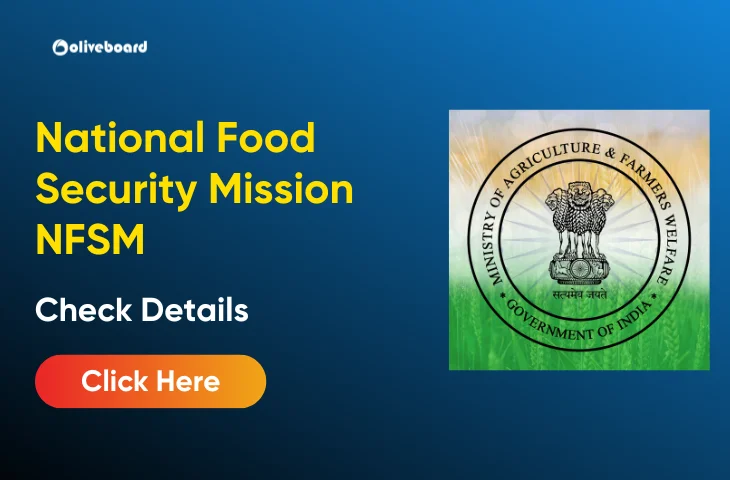National Food Security Mission NFSM
National Food Security Mission NFSM: The primary aim of the Mission is to narrow the yield gap for various crops by disseminating improved technologies and farm management practices. This article delves into the details of the program, its components, benefits, eligibility criteria, and the application process.
Overview table of National Food Security Mission
| Aspect | Details |
|---|---|
| Program Name | National Food Security Mission (NFSM) |
| Objective | Narrowing the yield gap for various crops by disseminating improved technologies and farm management practices. |
| Program Components and Benefits | – Seed distribution – Demonstration – Incentives for farmers – Supply of farm implements, bio-pesticides, micronutrients, and bio-fertilizers. |
| Demonstration Incentives | – Rs. 9,000/- and Rs. 15,000/- for sole crops and cropping-system based demonstrations respectively. – Rs. 6,000/- per hectare for coarse cereals. |
| Seed Distribution Assistance | Available for selected farmers, rates vary per crop, applicable for areas not exceeding 2 hectares each in a crop season. |
| Benefits of the Scheme | – Enhancing crop production and productivity – Promoting improved technologies and seed varieties – Assisting in nutrient and pest management – Providing flexibility for interventions such as farm implements and post-harvest technologies. |
| Eligibility Criteria | – All farmers eligible to apply – Specific allocation for Scheduled Castes, Scheduled Tribes, small, marginal, and women farmers – Assistance limited to 5 hectares per season for all farmers. |
| Selection of Districts | Based on factors including area, yield, and specific criteria for different crops. |
| Cluster Front Line Demonstration (CFLD) | – For ICAR-organized CFLD, each cluster must be at least 25 hectares – For state government-organized demonstrations, each cluster must be at least 100 hectares (25 hectares for Hilly and North East states). |
| Application Process | – Identification of beneficiaries by Gram Panchayats – Funds released to State governments with NFSM-EC approval – Funds distributed to State Level Agencies and then to District Level Agencies – Beneficiary allocation by District Level Agencies to Implementing Agency/beneficiary. |
| Documents Required | Aadhaar number, caste certificate (for SC/ST), bank details, and other relevant documents. |
National Food Security Mission Launch Date
The visionary National Food Security Mission (NFSM) was announced by the Union Government as part of the Atma Nirbhar Bharat package in 2020. This transformative scheme, implemented by the National Bee Board (NBB), is approved for three years from 2020 to 2023.
Program Components and Benefits
Under the program, farmers receive various incentives, including the production and distribution of seeds, supply of seed mini kits, Front Line/Cluster Demonstrations, improved farm implements, bio-pesticides, micronutrients, bio-fertilizers, and more.
Demonstration
- Incentives for crop demonstrations vary, with Rs. 9,000/- and Rs. 15,000/- provided for one-hectare areas for sole crops and cropping-system based demonstrations, respectively. For coarse cereals, the incentive is Rs. 6,000/- per hectare.
Seed Distribution
- Assistance for purchasing seeds is available to selected farmers, with rates varying for each crop. The assistance is applicable for areas not exceeding 2 hectares each in a crop season.
Benefits of the Scheme
The scheme aims to provide several benefits, including:
- Enhancing crop production and productivity.
- Promoting improved technologies and seed varieties through various demonstrations.
- Supporting the production and distribution of quality/certified seeds.
- Assisting in nutrient and pest management.
- Providing flexibility for interventions like farm implements, capacity building, water carrying pipes, and post-harvest technologies.
Eligibility Criteria of National Food Security Mission NFSM
All farmers are eligible to apply for the scheme. Specific criteria for the identification of areas and beneficiaries include:
- Allocation earmarked for Scheduled Castes and Scheduled Tribes.
- Allocation for small and marginal farmers (33%).
- Allocation for women farmers (30%).
- Assistance limited to 5 hectares per season for all farmers.
Selection of Districts
The selection of districts is based on various factors, including area, yield, and specific criteria for different crops.
Cluster Front Line Demonstration (CFLD) and Front Line Demonstration (FLD)
- For CFLD organized by ICAR, each cluster must be at least 25 hectares.
- For FLD organized by ICAR, each cluster must be at least 1 hectare.
- For state government-organized demonstrations, each cluster must be at least 100 hectares (25 hectares for Hilly and North East states).
Application Process of National Food Security Mission NFSM
The application process involves several steps:
- Identification of Beneficiaries: Involvement of Gram Panchayats in a transparent and time-bound manner.
- Funds Release: Funds are released to State governments with the approval of the NFSM-EC.
- Fund Distribution: Funds are released to State Level Agencies, which, in turn, allocate funds to District Level Agencies.
- Beneficiary Allocation: District Level Agencies release funds to the Implementing Agency/beneficiary.
Documents Required
To avail the benefits, farmers need to provide specific documents, including Aadhaar number, caste certificate (for SC/ST), and bank details. The required documents may vary based on the intervention and state, and applicants are advised to consult relevant authorities for detailed information.
Frequently Asked Questions
Ans: The primary aim of the NFSM is to narrow the yield gap for various crops by disseminating improved technologies and farm management practices.
Ans: Under the program, farmers receive various incentives such as seed distribution, demonstrations, supply of farm implements, bio-pesticides, micronutrients, and bio-fertilizers, aimed at enhancing crop production and productivity.
Ans: All farmers are eligible to apply for the scheme. Specific criteria for the identification of areas and beneficiaries include allocations for Scheduled Castes and Scheduled Tribes, small and marginal farmers, women farmers, and assistance limited to 5 hectares per season for all farmers.
Ans: District selection is based on various factors including area, yield, and specific criteria for different crops.
Ans: The application process involves steps such as identification of beneficiaries, funds release to state governments, fund distribution to state and district level agencies, and allocation of funds to implementing agencies/beneficiaries.
- RRB ALP Vs RRB JE, Which is Better Job?
- Central Bank of India Apprentice Exam Date 2025 Out
- SSC CHSL English Syllabus 2025, Check Detailed Syllabus
- SSC GD Constable Exam News & Next Notification Update
- SBI PO Handwritten Declaration 2025, Format, Image Size

